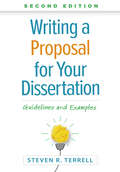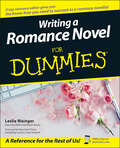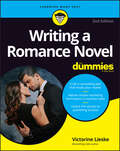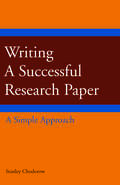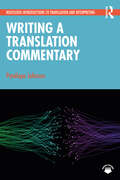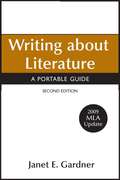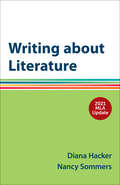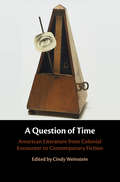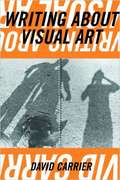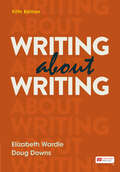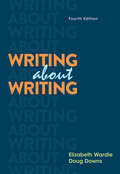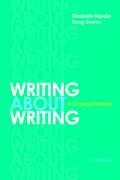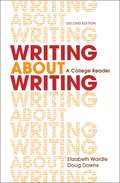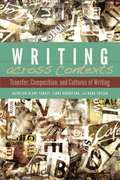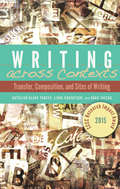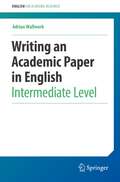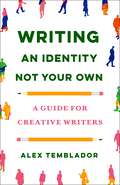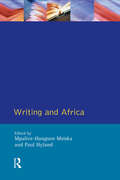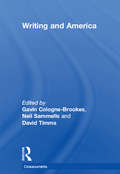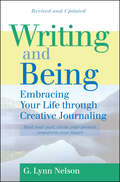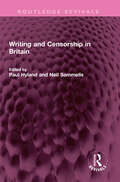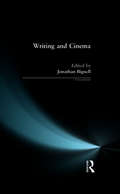- Table View
- List View
Writing a Proposal for Your Dissertation: Guidelines and Examples
by Steven R. TerrellThe encouraging book that has guided thousands of students step by step through crafting a strong dissertation proposal is now in a thoroughly revised second edition. It includes new guidance for developing methodology-specific problem statements, an expanded discussion of the literature review, coverage of the four-chapter dissertation model, and more. Terrell demonstrates how to write each chapter of the proposal, including the problem statement, purpose statement, and research questions and hypotheses; literature review; and detailed plans for data collection and analysis. "Let's Start Writing" exercises serve as building blocks for drafting a complete proposal. Other user-friendly features include case-study examples from diverse disciplines, &“Do You Understand?&” checklists, and end-of-chapter practice tests with answers. Appendices present an exemplary proposal written three ways to demonstrate quantitative, qualitative, and mixed methods approaches, and discuss how to structure a four-chapter dissertation. New to This Edition *Introduction offering a concise overview of the entire proposal-writing process and the doctoral experience. *Additional help with tailoring problem and purpose statements for quantitative, qualitative, and mixed-methods studies. *Expanded discussion of the review of literature, including a criterion for judging the quality of primary versus secondary sources. *Many new examples from different disciplines, such as studies of depression treatments, approaches to reducing offender recidivism, health effects of irradiated crops, strength training in college football, and remote teaching and learning during COVID-19. *Focus on the five-chapter model is broadened to include specific guidance for four-chapter dissertations. *Broader, more detailed reference list and glossary.
Writing a Romance Novel For Dummies
by Leslie WaingerIn love with romance novels? You’re not alone! Romance is today’s most popular fiction genre, accounting for more than half of all mass market fiction sold. If you’re looking to make a serious effort at writing a romance and getting it published in today’s multifaceted markets, you need to learn as much as you can about this highly successful field—especially how to create the perfect heroes and heroines. Now, in this easy, step-by-step guide, a top romance editor gives you the know-how you need to succeed as a romance novelist! Writing A Romance Novel For Dummies is perfect for both beginning and more accomplished writers who are looking to get the leading edge on writing a romance novel and get it published. Leslie Wainger, Executive Editor at Harlequin Books, explains what it takes to become the next Nora Roberts, providing the techniques you need to: Select a pseudonym Write a compelling, heartfelt story Find the right agent and publisher Submit a manuscript Market your novel Join clubs and associations Packed with insider advice, this plain-English guide helps you grasp the building blocks of a great romance, providing practical tips on the craft of writing as well as savvy pointers on how to hook your reader from page one, write with passion, and shape a proposal that will wow agents and editors. You get lots of expert tips on analyzing the marketplace, creating compelling characters, and finding your own voice. Wainger also: Demystifies the sub-genres of the romance world, from historical, contemporary, and multicultural to paranormal, romantic suspense, and Christian/inspirational Explains plotting, pacing, and writing those crucial love scenes Discusses how to conduct research, assign credits, and get permissions Helps you decide whether it’s best to write alone or with a partner Complete with a manuscript preparation checklist, tips for revising your work smoothly and successfully, guidance in understanding and negotiating a contract, and a list of romance writing resources, Writing A Romance Novel For Dummies is your one-stop guide to becoming a published novelist!
Writing a Romance Novel For Dummies
by Leslie Wainger Victorine LieskeGet your romance (writing) on! Writing a Romance Novel For Dummies is the only reference aspiring writers need to get their careers off to the right start. Fully updated to reflect the industry's latest trends and secrets, this book helps you understand what makes a great novel, so you can hone your craft and write books people want to read. We break down the romance subgenres, give you expert tips on plotting and pacing, and walk you through the process of finding an agent and getting published in today’s competitive market—or self-publishing like many six-figure authors are doing. For aspiring writers longing to find success in the industry, Writing a Romance Novel For Dummies is easy to read, highly informative, and a must-have! Refine your writing to craft engaging stories readers can’t put down Find a route to publication that works for you—mainstream, or self-published Understand the ins and outs of the romance genre and its subgenres Learn how to get your work noticed in the popular world of romantic fiction This Dummies guide is perfect for beginning writers who want advice on writing and publishing a successful romance novel. It’s also a great reference for accomplished writers looking to level up their romance game.
Writing a Successful Research Paper: A Simple Approach
by Stanley ChodorowThis brief, practical guide offers a clear and comprehensive strategy for conceptualizing, approaching, and executing the task of writing a research paper in the humanities and social sciences. In addition, it provides: a critical and process-oriented approach to the tasks of topic selection, formulation of the research question, thesis development, and argumentation.judiciously selected examples drawn from a broad range of disciplines.concise treatment of the aims, methods, and conventions of scholarly research, including the opportunities and pitfalls of Internet use.a wealth of conceptual and organizational tools, and more.
Writing a Translation Commentary (Routledge Introductions to Translation and Interpreting)
by Penélope JohnsonThis essential textbook is a step-by-step guide to how to write a self-reflective translation commentary, a key requirement of most courses on translation. Starting with source text analysis, it guides students in how to set out a translation strategy and goes through the most common challenging issues encountered, thus enabling students to set out their translation priorities in an informed manner. Throughout each chapter, there are boxes summarising key concepts and suggestions of tasks and activities, as well as recommendations for further reading. The book is supplemented by online resources for students and teachers on the translation studies portal. There are nine PowerPoints based on the chapters of the book that could be used for teaching or self-study. There are also downloadable versions of sample assessment rubrics, tables for example selection, and checklists. Based on real life examples of students' work in different language combinations, drawing on the author's years of experience of teaching commentary writing, this book focuses on several types of language mediation that go beyond the written word, such as interpreting, audiovisual translation, localisation, and transcreation. This is a vital textbook for students writing commentaries on translation and interpreting courses, a useful resource for supervisors providing students with guidance on how to write a balanced, articulate, and convincing commentary and a handy reference for professional translators and interpreters needing to explain their translation decisions to clients.
Writing about Archaeology
by Graham ConnahIn this book, Graham Connah offers an overview of archaeological authorship: its diversity, its challenges, and its methodology. Based on his own experiences, he presents his personal views about the task of writing about archaeology. The book is not intended to be a technical manual. Instead, Connah aims to encourage archaeologists who write about their subject to think about the process of writing. He writes with the beginning author in mind, but the book will be of interest to all archaeologists who plan to publish their work. Connah's overall premise is that those who write about archaeology need to be less concerned with content and more concerned with how they present it. It is not enough to be a good archaeologist. One must also become a good writer and be able to communicate effectively. Archaeology, he argues, is above all a literary discipline.
Writing about Discovery in the Early Modern East Indies (Elements in Travel Writing)
by Su Fang NgPortuguese explorations opened the sea-route to Asia, bringing armed trading to the Indian Ocean. This Element examines the impact of the 1511 Portuguese conquest of the port-kingdom of Melaka on early travel literature. Putting into dialogue accounts from Portuguese, mestiço, and Malay perspectives, this study re-examines early modern 'discovery' as a cross-cultural trope. Trade and travel were intertwined while structured by religion. Rather than newness or wonder, Portuguese representations focus on recovering what is known and grafting Asian knowledges-including local histories-onto European epistemologies. Framing Portuguese rule as a continuation of the sultanate, they re-spatialize Melaka into a European city. However, this model is complicated by a second one of accidental discovery facilitated by native agents. For Malay texts too, travel traverses known routes and spaces. Malay travelers insert themselves into foreign spaces by forging new kinship alliances, even as indigenous networks were increasingly disrupted by European incursions.
Writing about Literature A Portable Guide (2nd Edition, 2009 MLA Update)
by Janet E. GardnerWriting about Literature introduces strategies for reading literature, explains the writing process and common writing assignments for literature courses, provides instruction in writing about fiction, poetry, and drama, and includes coverage of writing a research paper and of literary criticism and theory. This volume in Bedford/St. Martin's popular series of Portable Anthologies and Guides offers the series' trademark combination of high quality and great value for teachers looking to assign supplementary instruction on reading and writing about literature to their students.
Writing about Literature with 2021 MLA Update: A Hacker Handbooks Supplement
by Diana Hacker Nancy SommersThis ebook has been updated to provide you with the latest guidance on documenting sources in MLA style and follows the guidelines set forth in the MLA Handbook, 9th edition (April 2021).Writing about Literature is a practical guide to interpreting works of literature and to planning, composing, and documenting papers about literature. Students will find help with forming and supporting an interpretation, avoiding plot summary, integrating quotations from a literary work, observing the conventions of literature papers, and using secondary sources. Writing about Literature also includes two sample student essays — one that uses only a primary source and one that uses primary and secondary sources.
Writing about Quantitative Research in Applied Linguistics
by Lindy WoodrowWith increasing pressure on academics and graduate students to publish in peer reviewed journals, this book offers a much-needed guide to writing about and publishing quantitative research in applied linguistics. With annotated examples and useful resources, this book will be indispensable to graduate students and seasoned researchers alike.
Writing about Time: Essays on American Literature
by Cindy WeinsteinThis book brings together leading critics in American literature to address the representation of time throughout a wide range of genres, methodologies, and chronological periods. American literature, from its beginnings to the present, provides a particularly rich set of texts to examine in this regard, with its interest in history, modernity and progress. Each essay considers how time embeds itself in a variety of textual representations, including Native American rituals, Shaker dances, novels, poetry, and magazines in order to provide readers with a capacious view of time's constitutive role in American literature. The essays are organized into four sections -- Materializing Time, Performing Time, Timing Time, and Theorizing Time. Each section reflects a particular approach to the question of time, but taken as a whole, the volume makes visible unexpected temporal patterns that cut across time period and genre.
Writing about Visual Art
by David CarrierDavid Carrier examines the history and practice of art writing and reveals its importance to the art museum, the art gallery, and aesthetic theory. Artists, art historians, and art lovers alike can gain fresh insight into how written descriptions of painting and sculpture affect the experience of art. Readers will learn how their reading can determine the way they see painting and sculpture, how interpretations of art transform meaning and significance, and how much-discussed work becomes difficult to see afresh.
Writing about Writing
by Elizabeth Wardle Doug DownsThis popular guide helps you master essential “threshold concepts” that will improve your writing.
Writing about Writing: A College Reader
by Elizabeth Wardle Doug DownsSince its initial publication, Writing about Writing has empowered tens of thousands of students to investigate assumptions about writing and to explore how writing works. It does so by making writing itself the subject of inquiry. Unique to Wardle and Downs’ approach, the text presents “threshold concepts” about writing―central ideas that writers need to understand in order to progress. As they come to a deeper understanding of these threshold concepts, students are able to transfer their understanding to any writing situation they encounter. This new edition has been refined and improved based on input from instructors using the text. Now with more explicit instruction to support academic writers, a new Part One explains the value of investigating writing, introduces threshold concepts and the notion of transfer, details the elements of genre and rhetorical reading, and offers a guide for conducting writing studies research at a level appropriate for undergraduates. The readings chapters have been updated and streamlined, and as in past editions they are supported with introductions, scaffolded questions, and activities. An extensive Instructor’s Manual by teacher-trainer Matt Bryan provides support for teaching with a writing-about-writing approach.
Writing about Writing: A College Reader
by Douglas Downs Elizabeth WardleA milestone in the field of composition, Writing about Writing continues to be the only textbook to provide an approach that makes writing studies the center of the introductory writing course. Based on Wardle and Downs's research and organized around major threshold concepts of writing, this groundbreaking book empowers students in all majors by showing them how to draw on what they know and engage with ongoing conversations about writing and literacy. The accessible writing studies research in Writing about Writing includes foundational research by scholars such as Nancy Sommers and Donald Murray, popular commentary on writing by authors such as Malcolm X and Anne Lamott, and emerging research from both scholars and student writers. Accessible explanations, scaffolded activities, and thoughtful questions help students connect to the readings and transfer their writing-related skills from first-year composition to writing situations in other college courses, work, and their everyday lives.The third edition makes studying writing even more accessible and teachable, with a new overview of rhetoric, a stronger focus on key threshold concepts, scaffolded reading guidance for challenging selections, and a new section in the instructor's manual with responses to frequently asked questions. The conversation on writing about writing continues on the authors' blog, Write On: Notes on Writing about Writing (a channel on Bedford Bits, the Bedford/St. Martin's blog for teachers of writing). Go to community.macmillan.com.
Writing about Writing: A College Reader 2nd Edition
by Elizabeth Wardle Doug DownsLiteracies : where do your ideas about reading and writing come from? -- Individual in community : how do texts mediate activities? -- Rhetoric : how is meaning constructed in context? -- Processes : how are texts composed? -- Multimodal composition : what counts as writing?
Writing across Contexts
by Liane Robertson Kathleen Blake Yancy Kara TacsakAddressing how composers transfer both knowledge about and practices of writing, Writing across Contexts explores the grounding theory behind a specific composition curriculum called Teaching for Transfer (TFT) and analyzes the efficacy of the approach. Finding that TFT courses aid students in transfer in ways that other kinds of composition courses do not, the authors demonstrate that the content of this curriculum, including its reflective practice, provides a unique set of resources for students to call on and repurpose for new writing tasks.The authors provide a brief historical review, give attention to current curricular efforts designed to promote such transfer, and develop new insights into the role of prior knowledge in students' ability to transfer writing knowledge and practice, presenting three models of how students respond to and use new knowledge--assemblage, remix, and critical incident.A timely and significant contribution to the field, Writing across Contexts will be of interest to graduate students, composition scholars, WAC and writing-in-the-disciplines scholars, and writing program administrators.
Writing across Contexts: Transfer, Composition, and Sites of Writing
by Kathleen Yancey Liane Robertson Kara TaczakAddressing how composers transfer both knowledge about and practices of writing, Writing across Contexts explores the grounding theory behind a specific composition curriculum called Teaching for Transfer (TFT) and analyzes the efficacy of the approach. Finding that TFT courses aid students in transfer in ways that other kinds of composition courses do not, the authors demonstrate that the content of this curriculum, including its reflective practice, provides a unique set of resources for students to call on and repurpose for new writing tasks. The authors provide a brief historical review, give attention to current curricular efforts designed to promote such transfer, and develop new insights into the role of prior knowledge in students' ability to transfer writing knowledge and practice, presenting three models of how students respond to and use new knowledge—assemblage, remix, and critical incident. A timely and significant contribution to the field, Writing across Contexts will be of interest to graduate students, composition scholars, WAC and writing-in-the-disciplines scholars, and writing program administrators.
Writing an Academic Paper in English: Intermediate Level (English for Academic Research)
by Adrian WallworkThis book is for university students, with at least a mid-intermediate level of English. It can be used as part of an English for Academic Purposes (EAP) course, either alone or with the companion volume Giving an Academic Presentation in English. The chapters are independent so that EAP teachers and students can choose those sections that best fit their needs. This means that a course can range from a minimum of 20 hours, up to 60 hours or more. There is an introductory chapter that includes what role academics play in today’s world, where success is not just measured in terms of paper output but also involvement in interdisciplinary projects and supporting society at large. Each chapter covers a particular section of a paper (Abstract, Introduction, Methods etc) and begins with a discussion exercise on what the exact purpose of each section is. This purpose is also highlighted by comparisons with non-academic situations where similar skills are required. There are many examples and templates – none of which are lengthy or complex - but which are designed to highlight key points. Students learn what style to adopt (we vs impersonal), the correct tenses to use in each section, typical mistakes, and useful phrases. The course is highly practical and is also designed to be fun to use. Other books in the series: Giving an Academic Presentation in English Essential English Grammar and Communication Strategies Adrian Wallwork is the author of more than 40 ELT and EAP textbooks. He has trained several thousand PhD students and researchers from around 50 countries to write research papers and give presentations. He is also the co-founder of e4ac.com, an editing agency for non-native English-speaking researchers.
Writing an Identity Not Your Own: A Guide for Creative Writers
by Alex TembladorA practical guide to help authors authentically write and edit a character whose identity is different than their own.Do you have the tools to authentically write and edit a character whose identity is different than your own? It’s not a subject that’s generally taught in creative writing programs, and there are so few craft books and online resources on the subject. Even if you can take a seminar, class, or workshop, there’s nothing like having an easy-to-understand book on hand to provide guidance and insight every time you craft characters with historicallymarginalized identities.In Writing an Identity Not Your Own, award-winning author Alex Temblador discusses one of the most contentious topics in creative writing: crafting a character whose identity is historically marginalized. What is “identity,” and how do unconscious biases and bias blocks impact and influence what we write? What is intersectionality? You’ll learn about identity terms, stereotypes, and tropes, and receive genre-specific advice related to various identities to consider when writing different races and ethnicities, sexual and romantic orientations, gender identities, disabilities, nationalities, and more. Through writing strategies, exercises, and literary excerpts, writers will gain a clearer understanding on how misrepresentations and harmful portrayals can appear in storylines, dialogue, and characterization. Alex will guide writers from the brainstorming phasethrough the editing process so they can gain a full understanding of the complexities of writing other identities and why it’s important to get them right.
Writing and Africa (Crosscurrents)
by Paul Hyland Mpalive-Hangson MsiskaThis volume reflects one of the new areas of English Studies as it broadens to take in non-western literatures, and places more emphasis on the contexts and broader notions of `writing'. In discussing writing from and about Africa, this collection touches on studies in black writing, colonialism and imperialism and cultural development in the third world. It begins by providing a historical introduction to the main regional traditions, and then builds on this to discuss major issues, such as oral tradition, the significance of `literature' as a western import, representations of Africa in western writing, African writing against colonialism and its themes and politics in a post-colonial world, popular writing and the representation of women.
Writing and America (Crosscurrents)
by David Timms Gavin Cologne-Brookes Neil SammellsWriting and America surveys the writing genres that have contributed to the American notions of America . Essays from scholars from both side of the Atlantic chart the range of responses to American nationhood from colonial times to the present and include dissenting responses from communities such as native American, black and feminist writers. Case studies from writers such as James Fenimore Cooper and William Carlos Williams provide a framework for discussions on topics such as colonial notions of America as the promised land, the discourses of nationhood in the republic, the sense of nationhood in American historiography, and the formation of the American Canon. Draws upon extracts from the American Bills of Rights and the Constitution as examples of different types of writing.
Writing and Being: Embracing Your Life Through Creative Journaling
by G. Lynn NelsonWith powerful, practical, step-by-step writing exercises, a wealth of examples, and stories of personal transformation through journaling, Writing and Being demonstrates that intentional, guided journaling is a profound way to discover one's authentic self. Beyond mere diary writing, these creative journaling methods help readers chart a path for a better future. The book begins by providing tips for the logistics of journal keeping, and includes suggestions for getting started. It then explores the entire writing process and explains the distinctions between private writing and public writing. The book also explains the biology behind the powerful experience of journaling by laying out recent discoveries about the human brain, showing how journaling can heal psychological and spiritual wounds. Finally, the author shows how to make journaling both a voyage of self-discovery and a means of sharing one's journey and inspiring others in a caring community of expanding love, support, and positive energy.
Writing and Censorship in Britain (Routledge Revivals)
by Neil Sammells Paul HylandFirst published in 1992, Writing and Censorship in Britain explores the issue of censorship, from a range of cultural and literary perspectives, from the Tudor period to the 1990s. Written by some of the leading experts in the field, this collection charts the struggles for artistic expression, reveals how censorship is appropriated as a legitimate tactic in the defence of oppressed and marginalised groups, and analyses the struggles writers have employed in the face of its complex dynamics. Here variously defined, defended and deplored, censorship emerges as both an unstable and a potent concept. Through it we define ourselves: as readers, as writers and as citizens. This book will be of interest to students of literature, history and law.
Writing and Cinema (Crosscurrents)
by Jonathan BignellThis collection of essays examines the ways in which writing and cinema can be studied in relation to each other. A wide range of material is presented, from essays which look at particular films, including The Piano and The English Patient, to discussions of the latest developments in film studies including psychoanalytic film theory and the cultural study of film audiences. Specific topics that the essays address also include: the kinds of writing produced for the cinema industry, advertising, film adaptations of written texts and theatre plays from nineteenth century 'classic' novels to recent cyberpunk science fiction such as Blade Runner and Starship Troopers. The essays deal with existing areas of debate, like questions of authorship and audience, and also break new ground, for example in proposing approaches to the study of writing on the cinema screen. The book includes a select bibliography, and a documents section gives details of a range of films for further study.
